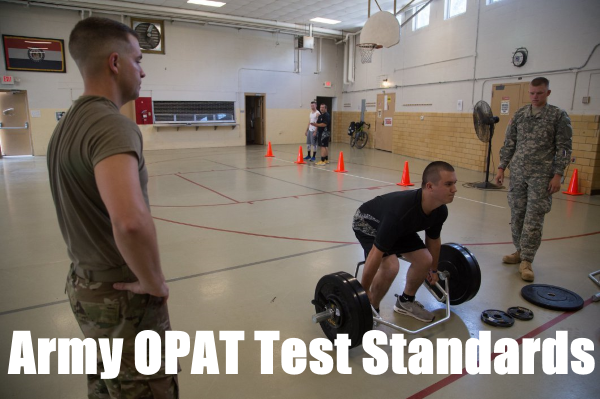Basic Combat Training is the first step to joining the U.S. Army after enlistment.
The training introduces new recruits to the culture of the Army along with a series of physical fitness requirements.
Unfortunately, in the past, some recruits have struggled to meet the requirements of basic training.
As a result, the U.S. Army introduced the OPAT Test in 2017.
The Occupational Physical Assessment Test (OPAT) consists of 4 physical fitness tests.
It’s designed to provide recruits with the tools necessary to succeed in the United States Army.
Continue reading to learn more about the OPAT Test, including the specific exercises and requirements.
Related Article – Army Height & Weight Standards
Table of Contents
#1. What Is the OPAT Test?
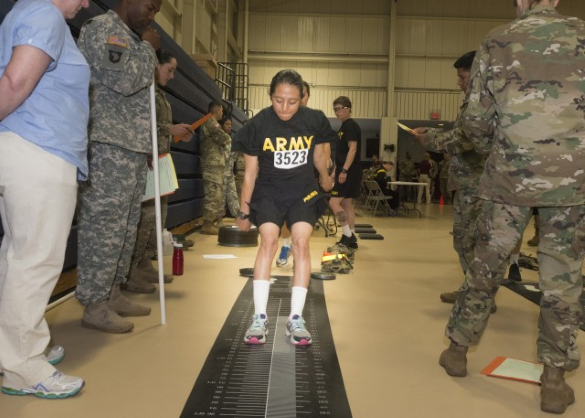
The Occupational Physical Assessment Test (OPAT) is an entry fitness test for new recruits.
It measures the speed, conditioning, and strength of each incoming service member.
The U.S. Army combines the OPAT score with mental and psychological evaluations to determine an appropriate MOS assignment for each recruit.
Additionally, the Army created the OPAT Test for active-duty members who are seeking to transition into a new Military Occupational Speciality (MOS).
In general, all soldiers who complete basic training are considered physically ready for service.
However, the OPAT provides the Army with a more precise evaluation of each individual’s strengths and weaknesses.
It also serves as a benchmark for the physical fitness standards and expectations of the U.S. Army.
Therefore, those considering enlisting in the Army can receive an idea of what they’ll need to accomplish to thrive in the service branch.
The Occupational Physical Assessment Test consists of 4 different exercises/tests.
Each exercise in the OPAT Test is designed to assess your physical capabilities for various tasks in the Army.
It monitors upper and lower body strength as well as lower body strength, and aerobic endurance.
The United States Army introduced the OPAT Test in 2017 following depleting enrollment numbers.
It’s an attempt to better prepare recruits for the intense demands and expectations of the U.S. Army.
It also allows the Army to determine appropriate MOS placement along with avoiding unnecessary injuries during Basic Combat Training.
It’s typically administered by Recruiting Command after the recruit swears in but before they begin basic training.
The OPAT Test is administered to every new soldier (officer, enlisted, active, Reserve, or Guard).
All in all, the evaluation enables the Army to put recruits in the best position to succeed.
#2. OPAT Test Exercises
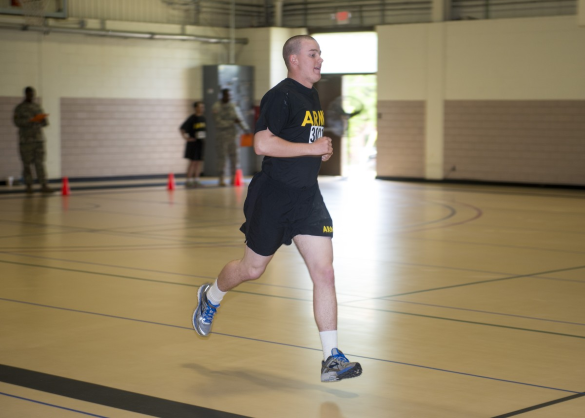
The Occupational Physical Assessment Test revolves around 4 primary exercises.
The OPAT Test is designed to measure the general strength and fitness of each new recruit.
It can also serve as an assessment for active-duty soldiers who are seeking to move to a new MOS.
The 4 events in the Army OPAT Test are:
- Standing Long Jump
- Seated Power Throw
- Strength Deadlift
- Interval Aerobic Run
It’s important to make yourself aware of each exercise if you are considering joining the U.S. Army.
New recruits must achieve satisfactory results in each exercise, so practicing beforehand is wise.
Succeeding in the OPAT Test will grant you more opportunities within the service branch or allow you to transfer to another MOS later on down the road.
Let’s examine each exercise in more detail:
Standing Long Jump
The standing long jump is a straightforward exercise.
It’s one of the best exercises for measuring lower body strength.
Furthermore, it doesn’t require any equipment so anyone can practice.
As the name implies, the exercise measures the distance a recruit can leap from a standing position.
The Army measures your distance from the take-off line to the rear-most heel.
More importantly, you must land in a stable/standing position for the jump to officially count.
The key to the standing long jump is to emphasize the knees and arms.
Therefore, when you practice, focus on launching off bent knees while swinging the arms forward.
It will provide you with more forward momentum and, ultimately, a further distance.
Lastly, the standing long jump favors those who are lighter in weight.
For this reason, we suggest burning fat and getting to an ideal weight in preparation for basic training.
Seated Power Throw
The U.S. Army utilizes the seated power throw to measure upper body power.
Thus, recruits maintain a seated position with their backs against a yoga block and the wall behind them.
The posture is critical because the wall prevents you from being able to use your back for momentum.
As a result, the seated power throw demonstrates strength purely in the arms and chest.
Recruits conduct the test in a seated position (lower back against a yoga block and upper back against the wall) while throwing a weighted medicine ball (4.4 lbs).
Then, the distance of the ball is recorded for the OPAT Test.
There are several methods for improving upper body strength and endurance (more information, below).
Strength Deadlift
The strength deadlift, or hex-bar deadlift, is another exercise of the OPAT Test.
It monitors your lower-body strength like the standing long jump.
However, your weight does not play quite as large of a factor as the primary muscles of focus are the hamstrings, quads, glutes, and lower back.
The hex-bar provides stronger balance compared to a standard lift-bar where individuals stand behind the weight.
Thus, balance is not nearly as large of a factor as pure strength.
The exercise progresses in succession with each successful weight cleared.
Recruits are granted two unsuccessful attempts before a final weight is calculated.
Failure to lift a certain weight reverts the score back to the previous weight lifted.
Interval Run
The interval run is either a personal favorite or one of the most dreaded parts of the OPAT Test, depending on preference.
For some, running an endurance test is far easier than lifting weights or heaving a medicine ball.
Nevertheless, all new recruits are expected to pass the interval run with a satisfactory score.
The interval run monitors cardio in a series of timed runs across a 20-meter distance.
The allowed time to complete each interval (20 meters) gradually decreases as the run continues.
Accordingly, the aerobic exercise gets more challenging with each passing 20-meter interval.
The specific rules of the interval run get a little complicated but the intentions are clear.
You should focus on improving cardiovascular activity in preparation for basic training.
The Army interval run determines the general lung capacity and overall conditioning of each recruit.
#3. OPAT Test Standards / Requirements
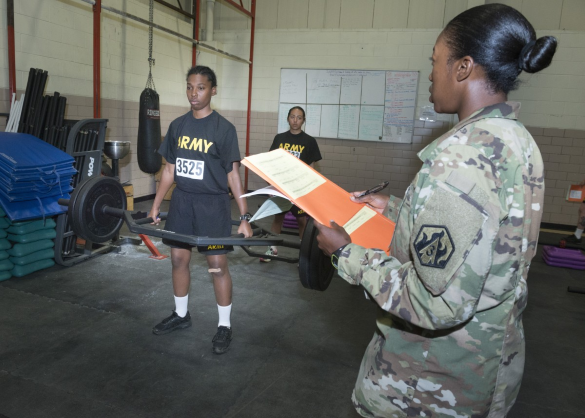
The purpose of the Army OPAT Test is to provide recruits with the physical tools necessary to thrive in the military branch.
The OPAT Test was implemented to prevent the rising number of injuries associated with Basic Combat Training.
Henceforth, the U.S. Army reclassified physical fitness standards in 2017 to reflect 4 categories/demands.
The physical demands are divided based on anticipated regular lifting requirements of the MOS:
- Black = Heavy Physical Demand (99+ lbs.)
- Gray = Significant Physical Demand (41-99 lbs.)
- Gold = Moderate Physical Demand (40 lbs. or less)
- White = Unqualified / Unsatisfactory
All in all, the goal is to achieve anything but “white” (unqualified) status on the OPAT Test.
Additionally, the type of status you need to achieve on the OPAT varies depending on your intended Military Occupational Speciality (MOS).
For example, a physically demanding MOS may require black or gray status, while other occupations may only call for gold status.
Thus, the OPAT Test is also utilized by the Army to access active-duty members seeking to transfer to a new MOS.
However, the OPAT is only necessary for soldiers seeking to advance to an MOS that requires a higher physical demand.
It’s worth noting that the OPAT Test is “gender-neutral,” meaning the same fitness standards exist for both men and women.
As a result, the test requirements vary by designated career field (and not gender).
Army OPAT Physical Demand Standards
These are the minimum benchmarks necessary to attain a certain “physical demand” status in the U.S. Army:
| Physical Demand | Standing Long Jump | Seated Power Throw | Strength Deadlift | Interval Run |
|---|---|---|---|---|
| Black | 5' 3" (160 cm) | 14' 9" (450 cm) | 160 lbs. | Level 6-2 (43 shuttles) |
| Gray | 4' 7" (140 cm) | 13' 1" (400 cm) | 140 lbs. | Level 5-8 (40 shuttles) |
| Gold | 3' 11" (120 cm) | 11' 6" (350 cm) | 120 lbs. | Level 5-4 (36 shuttles) |
| White | Unqualified | Unqualified | Unqualified | Unqualified |
Recruits have one hour to complete the OPAT Test.
#4. How Can I Prepare For The OPAT Test?
There are several ways to prepare for the Army OPAT Test.
For starters, focus on reaching peak physical condition prior to Basic Combat Training.
It will not only allow you to arrive in the best physical shape possible but grant you the tools necessary to thrive in the U.S. Army.
For most, the interval run is the most dreaded part of the OPAT Test along with other endurance tests that take place during basic training.
Thus, there is no substitute for aerobic exercises like jogging, cycling, or running stairs.
These exercises may suck, but they’ll burn excess fat and help you reach full potential.
Furthermore, strength training is necessary since it’s a major aspect of the OPAT.
Thus, subscribe to a training routine that also builds your upper and lower body strength.
There are a wide variety of arm and leg exercises that do not even require membership to a gym.
Nonetheless, recruits who lift weights (squats, leg presses, etc.) will notice a remarkable improvement in strength training.
Medicine balls are readily available at gyms and can help you practice for the seated power throw.
Moreover, practicing all of the events prior to the OPAT Test will get you prepared for the real deal.
It will also provide a baseline for what exercises you need to improve upon in order to achieve the physical demand status you desire for a particular MOS.
Recruits should allow at least 3-6 months in advance of basic training to prepare for the OPAT.
In general, it’s smart to start slow and gradually increase the intensity until you reach the desired results.
#5. Frequently Asked Questions (FAQ)
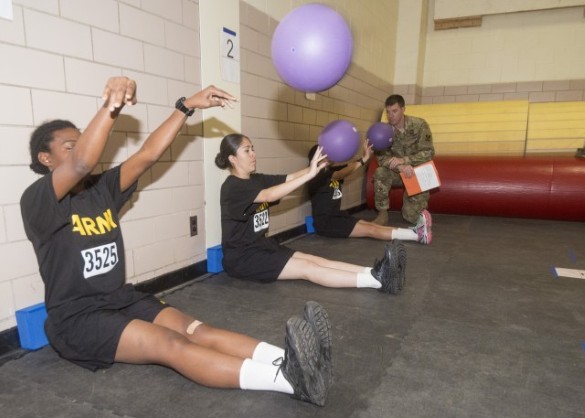
Here are some frequently asked questions about the U.S. Army OPAT Test:
How long is the OPAT test?
Recruits must complete all 4 events in the OPAT Test in an hour.
You can prepare for the OPAT by practicing mock assessments.
It will introduce you to the pace and demands of the test.
Furthermore, it will establish a baseline for your scores — indicating which events you need to improve upon before the real deal.
What is a passing OPAT score?
There are 3 passing scores/physical demands for the Army OPAT Test:
- Black
- Gray
- Gold
All 3 are satisfactory for service yet may not qualify you for every Military Occupational Specialty (MOS).
Thus, it’s important to understand the physical demands of your desired MOS beforehand.
“Black” is the highest physical demand and is associated with combat roles where soldiers regularly lift or move 99 lbs. or more.
Meanwhile, “gray” and “gold” status is reserved for moderate and light-lifting military occupations.
Thus, the fitness standards are not nearly as demanding compared to combat roles/black status.
How long is the OPAT run?
The OPAT run lasts as long as you can survive.
The challenge to the interval run is that you have less time to complete each 20-meter segment as it progresses.
Therefore, stamina and endurance are at the heart of the interval run.
Your total time is calculated by adding all of the intervals together to reflect a one-mile run.
You’ll also note that each physical demand status designates how many shuttles you are granted to make the designated time.
Can you fail the OPAT?
Yes, you can fail the OPAT by receiving “white”/unqualified status.
Recruits who attain this level fail to meet the basic fitness standards of the U.S. Army.
Those that fail the OPAT Test can request to retake the test at a later date.
It’s possible to transfer to another MOS in the event you fail to meet the fitness standards.
However, you can avoid a lot of frustration and hassle simply by being prepared in advance.
There is nothing that beats cardiovascular and strength training in preparation for the OPAT.
Conclusion
The Army Occupational Physical Assessment Test (OPAT) is the new, revised fitness standard for the military branch.
It was created in 2017 to more appropriately assign troops based on cardio and strength capabilities.
As a result, those seeking combat roles are tested differently compared to non-combat/light-lifting occupations.
Nevertheless, you should prepare for the Army OPAT several months prior to arriving for basic training.
It will allow you to get into better shape while practicing the events that will take place on the test.
- Ikon Pass Military Discount: Learn How To Save Big - January 31, 2025
- RTIC Military Discount: Find Out How To Save Big on Gear - January 30, 2025
- Traeger Military Discount: Learn How To Save Big on Smokers - January 28, 2025

